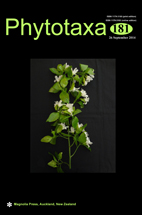Type: Article
Published: 2014-10-01
Page range: 110–119
Abstract views: 18
PDF downloaded: 1
Evolution of cyme architecture in Celastraceae
Laboratory of Systematic Evolution and Biogeography of Woody Plants, College of Nature Conservation, Beijing Forestry University, Beijing100083, China
Laboratory of Systematic Evolution and Biogeography of Woody Plants, College of Nature Conservation, Beijing Forestry University, Beijing100083, China
Cixi Municipal Bureau of Agriculture, Cixi, Zhejiang Province 315300, China
Laboratory of Systematic Evolution and Biogeography of Woody Plants, College of Nature Conservation, Beijing Forestry University, Beijing100083, China
Cyme
Celastrus
Euonymus
inflorescence architecture
morphogenesis
transition

